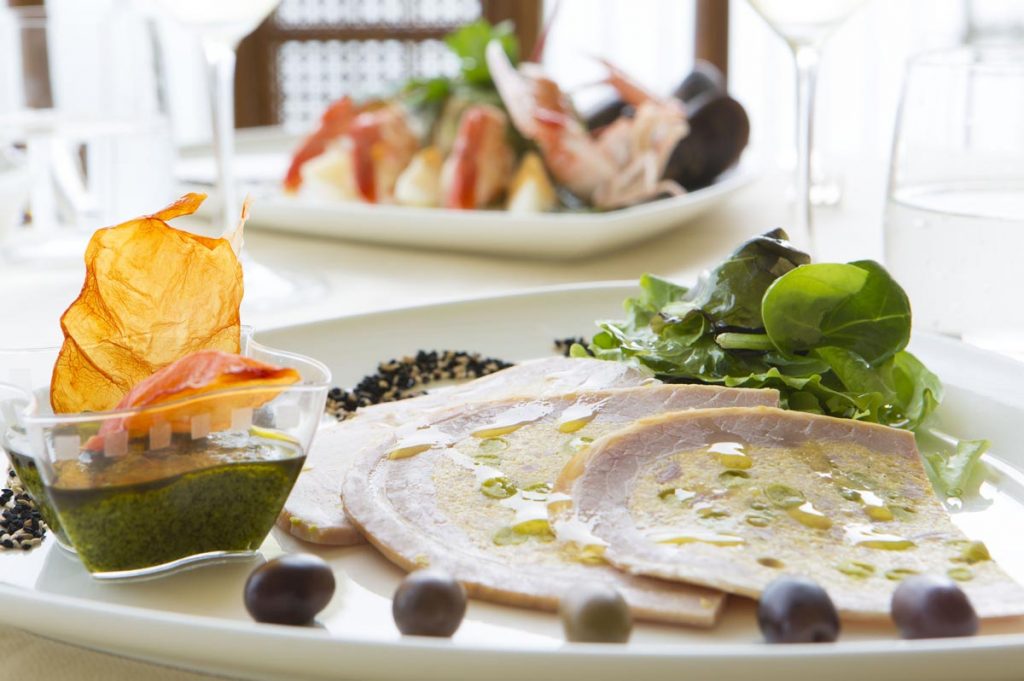Amongst all the typical Ligurian dishes, today we will talk probably about one of the most odd and unique ones. Why so? Because to prepare it, pots and knives are just not enough… you must have a needle and some thread!
Clearly we are talking about Genoese cima: a typical but not well known dish, that surely will surprise you: both because of its (delicious!) taste, and for its presentation as well as its preparation.
What is genoese cima?
Cima is a dish made of veal stomach filled with vegetables and meat.
The stomach is used as a poach: it is filled with different types of filling and sewed up, so that the tasty filling does not scatter in the pot.
Once prepared (we will discuss it later), the cima is cut into slices and are served cold.
Each slice is called “éuggio” (eye) because of its shape and look: the meat that surrounds the filling, the coloured filling, and often also the hard-boiled eggs right in the middle, they all remind an eye.
Cima is a main course dish made of meat and vegetables, prepared with some variations in whole Liguria: from east to west.
The recipe for the filling is slightly different in each area.
This is because long time ago, this dish originated as a poor dish, created in order to avoid wasting food.
The filling was made with the ingredients they already had in the house: the only rule was never throw anything away!
Amongst the existing versions we decided to recommend the most famous and the closest to our tradition: the Genoese one.
Cima: The original recype by our chef Remo Gatto
Ingredients:
Veal:
- De-boned stomach (per poach) approx. 2kg
- Sweetbreads 100gr.
- Testicles 100gr.
- Brains 100gr.
- Snout 100gr.
- Lean meat 100gr.
Pork:
- Ham 100gr.
Vegetables and fresh spices:
- Peas 100gr.
- Carrots x 2
- Marjoram (leaves) 6 branches
- Garlic clove x1
- White onion 50gr.
- Pine nuts 30gr.
- Ground black pepper (depends on taste)
- Sea salt (depends on taste)
Thikening sauce:
- 8 Fresh eggs L
- 2 hard boiled eggs
- Stale bread 100gr.
- Grated Grana Padano 50gr.
- Extra virgin olive oil 30ml.
Conductor of heat:
- Vegetable broth 10l.
Preparation:
First of all, you have to have a needle and some thread to sew the veal stomach, forming a poach that will be stuffed with filling (and ten you can sew the remaining part).
For the filling: peel and cut the onion into small cubes (size of a pea).
Sauté the onion in some oil and some minced garlic, then add some previously minced pulp and snout.
Blanch the brains, sweetbreads and testicles in boiling water, then clean and chop into cubes.
Afterwards, you have to add them to the soffritto sauce, together with the chopped ham.
Brown it and simmer with dry white wine. Then take it off the stove and let cool.
Put the eggs, the stale bread (previously dunked in some broth and then squeezed) and the grated cheese with some marjoram, in a steel bowl.
Whisk it all vigorously and season with salt and pepper.
Add the pine nuts, (previously blanched) peas and (whole) carrots, hardboiled eggs and the previously prepared meat to the compound.
You can now mix everything together. Afterwards, pour the compound in the veal’s pouch, being careful not to exceed the ¾ of its capacity (in order to prevent it from overflowing).
Sew the pouch completely and check that it is well sealed from all sides.
Put the meat in a tight cloth (cotton or linen), wrap it twice and tie it with some thread (like a roast).
At this point you can cook it. It is usually prepared in a fish kettle, to be filled by half with cold vegetable broth.
Immerse the meat and bring at boiling point. Afterwards, reduce the flame and let simmer for roughly 2h, punching it wit a needle from time to time, so as to help the steam to come out, without damaging the meat that contains the filling.
Once cooked, drain the cima, and, still warm and wrapped, place it between two wooden or polyethylene sticks and a heavy object on top.
Let sit in a cool and ventilated area. By doing this, the water in excess gets out and the cima takes its characteristic shape.
Cima can be served both hot and cold, cut into thin or thick slices, with hot and cold side sauces and even fried
Some people like it warm, cut into thin slices, slightly au gratin and with rich “salsa verde”.

